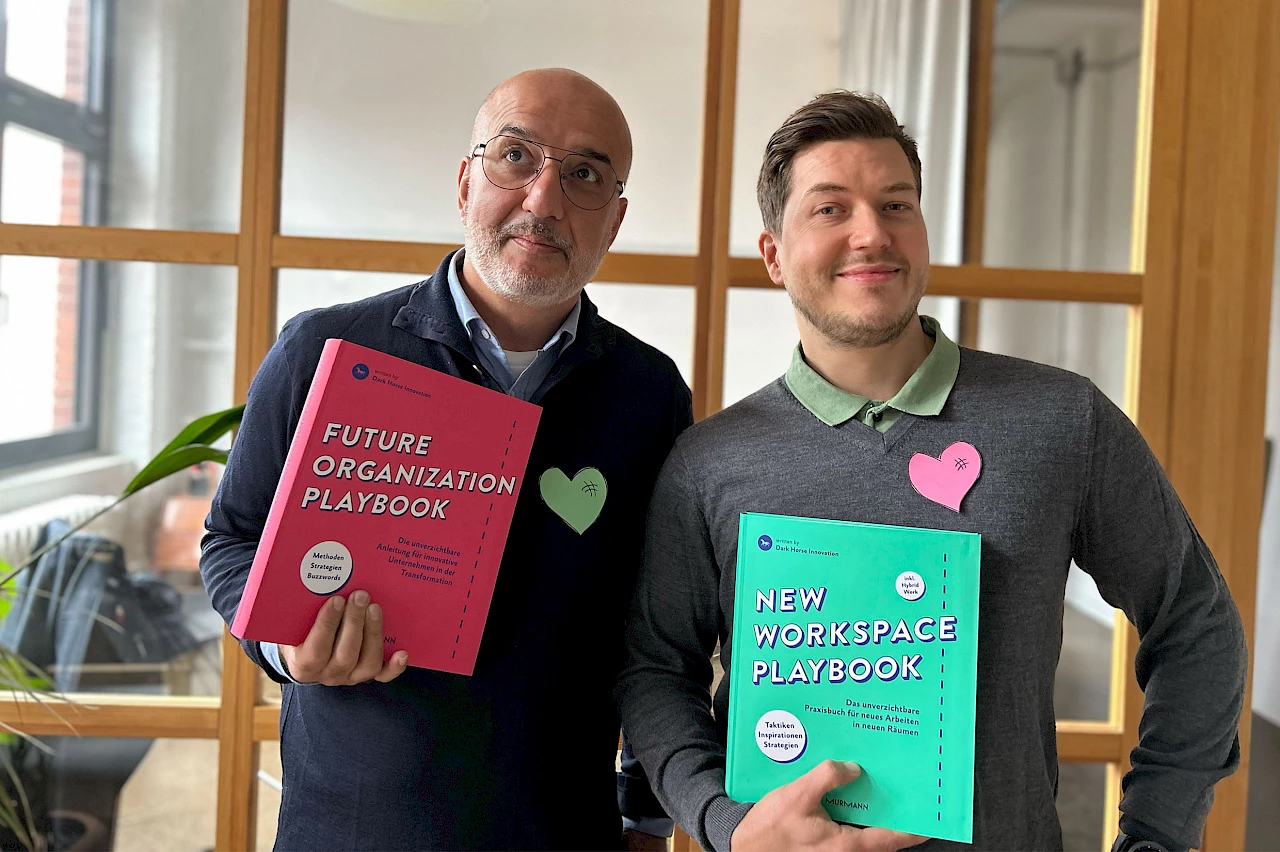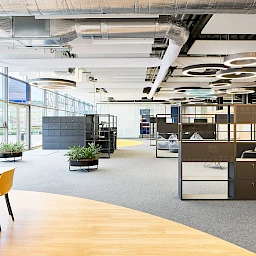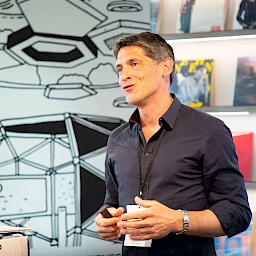The world of work is changing rapidly. Teamwork, agility and creativity are increasingly characterizing our jobs. However, our work environments often lag behind. This makes work unattractive and inefficient. An interview with Christian Beinke from Dark Horse Innovation and Erkan Karakoç from Dark Horse Workspaces about new work environments and innovation design.
Work has developed from routine activities to include more and more activities that involve problem-solving. But work environments often lag behind this development. What attributes do work environments need in order to enable creativity, communication and innovation?
Christian Beinke: I would even question the initial statement a little. I don’t believe that work has dispensed with routine activities altogether. It’s an interesting perception, but the two things, work and problem-solving, always occur together. And of course knowledge work is also partly routine work, because the basic goal of an organization is to make work a routine. Routines will continue to exist in the future, even though AI is threatening to automate a part of knowledge work. In addition to routine work, there’s the part of work that we often perceive as being more valuable. This part of the development is always, in a certain sense, a type of problem-solving. In this area I would completely agree with the statement. That’s why it will be important in the future to develop an understanding of the following aspects: what kind of work am I doing in a company, how can I organize it especially well and in line with the existing structure, and what are the right operation modes or the perfect work environment for it?
Erkan Karakoç: The core concern is to get the employees on board and to understand how and in what operation modes they are working. The next step is to formulate a DNA for each department that describes how much individual work, how much teamwork and how much focused work or even socializing there is in the day-to-day work. If this is extrapolated to extend to the company as a whole, you can identify the users’ needs very clearly, and this is then the basis for designing work environments accordingly. Always with an eye on the concrete work the employees are doing and on their intensity. From these factors we can deduce the corresponding attributes of the spatial environment. What stands out in the course of hybrid working is that the office has to offer multifaceted opportunities. For example, it must offer opportunities to do concentrated work via special solutions such as libraries where people can work in a calm and focused way. By contrast, spaces where people can socialize, such as marketplaces, are also becoming more important.
“If you’re always working online at home, when you’re in the office you mainly want to meet people or, on the other hand, you want to do focused work of the same quality as the work you do at home.“ Erkan Karakoç
In your book Thank God It’s Monday, you write that if it’s really a matter of new forms of work, innovation is always the central focus. And innovation requires an entire culture, not just a method. That’s why you’ve reinterpreted design thinking at Dark Horse Design Thinking and why you talk about “designification”. What exactly do you mean by that?
Christian Beinke: We published the book in 2013 because back then we were moving along a path of knowledge as an innovation agency. In spite of the wave of innovation and all the hype since 2006/2007, during which many companies set out on the path toward more innovation, we were forced to conclude that the corresponding culture and the corresponding spaces were lacking. We therefore created a network for ourselves, because whenever we visited our clients they would say things like “We can’t work very well here.” So we invited them to visit us. And this emergence from their own work environment into a space that was specially designed by Dark Horse in terms of defined rules really helped the clients to think in a completely new way. As a result, at some point we arrived at the concept of designification, because we realized that everything can be designed. Design doesn’t end with products and services; instead, it extends across all levels of organization. Companies can and must be designed — their culture, structure, goals, strategy and also their environment. Back then we felt that we were at the beginning of an era of designification, when more and more people are realizing that they shouldn’t remain passive but instead should actively shape their (working) world if they want it to be liveable over the long term.
What we’re observing today is the existence of a wide spectrum of companies — some whose innovation culture is at a very high level, but also others that are still at the very beginning. Another thing we’re observing is that recently there have been more and more public-sector companies that are active in the field of innovation. It’s incredible how much has been done in this area in recent years, and it shows that for many organizations it’s worthwhile to invest more in the cultural transformation and innovation.
Being innovative means doing things differently. Thinking in new ways, trying things out, exploring limits — after all, people want to get out of the box and expand their horizons. What does this mean for the office of the future? What function will it fulfil, and what attributes does it need for this purpose?
Erkan Karakoç: In the course of our work at Dark Horse Workspaces, we defined three categories of hybrid work companies. First, there are companies that say their employees must be in the office four days per week. Here the goal is to protect the organization and preserve the capacity for innovation by means of the employees’ joint presence, chance encounters and shared development of ideas. Secondly, there are companies that say, for opportunistic reasons, that it’s okay for their employees to work for two days at home and three days in the office. They believe that otherwise none of their employees will come to work in the office and that the company isn’t modern enough to attract new employees. Thirdly, there are companies who regard their employees as empowered people for whom entrepreneurial thinking and acting on their own responsibility is standard procedure. This means that the employees might only meet in person once a week or once a fortnight in order to coordinate, because their work is organized in ways that do not diminish their performance. Here the topics of identity and culture are of course harder to grasp, because people don’t see each other as frequently. The office of the future must be regarded within this spectrum. How will companies organize themselves and define the principles that underlie their work? And what do they and their employees need in order to deliver optimal performance? This setting is the basis which gives rise to the work environment. People who come to the office four times a week need every possible mode of operation to be available to them on site. By contrast, empowered employees must have a marketplace available to them as well as sufficient opportunities to work in a quiet setting. The office of the future will thus be located on this spectrum. In this context, an optimized work environment is always oriented toward the needs of its respective users.
Christian Beinke: I find it intriguing that there’s no universally valid answer to this question. Precisely because the world of work has gone through such incredible changes as a result of hybrid working, companies must think about space in a completely new way. Space is now becoming a part of corporate strategy. Suddenly, I need to think about what people in the organization need in order to be able to do good work. Meanwhile, there’s something we could call social needs — the employees as human beings — otherwise they won’t come to the office any longer. In other words, I also have to take the socioeconomic context into account. And within this context I have to strategically consider how I design workspaces so that I can remain competitive as a company. This is a strategic question that simply did not come up ten years ago. Suddenly space is a distinguishing feature and a strategic tool for companies. I find this aspect of the transformation especially interesting.
What’s your vision of the future office?
Christian Beinke: I believe in the legitimacy of needs — in other words, not the normative “That’s how things are now” but instead the individual definition of the perfect workplace. After all, the ultimate goal is always to do the best work possible. That’s the first step. In addition to good work, the issue is how I develop as a person and as an employee. That brings us to the topic of learning, which is extremely multifaceted and complex. I can learn through my own initiative, feedback and watching my colleagues — which is absolutely impossible when I’m working from home. I can also learn through seminars, but then I still need feedback during my daily work. In other words, communication is very important here. And learning is part of me as an employee who wants to continue developing. That brings us back to the distinguishing feature I mentioned before. Every company must define one thing for itself: How can I be better than other companies on the market while also being better as an organization? Of course this definition also includes the employees and their skills, because they make the company unique and create a competitive advantage. Of course I must also offer this competitive advantage by means of the work environment. Employees need a work environment in which they can perform optimally. And that takes us back to the point that Erkan touched upon before. If my distinguishing feature is my total efficiency, I need a work environment that is totally efficient. If my distinguishing feature is being more innovative than my competitors, I need to offer a work environment in which my employees can also get together in order to communicate, develop ideas and have the free space they need for their work. On the basis of my company-specific distinguishing feature — and this is a strategic question — I must structure my work environment in a way that makes it perfect for the employees and maximizes their competitive or skills advantage. If I do that, the space automatically becomes an individual solution that matches the respective company and is unique.
Erkan Karakoç: Just a small addition. When the employees are included in the design process, that’s the icing on the cake. If this happens, they identify themselves with the spaces. They know that this is their Monday workplace, a place they like to come back to after the weekend, where they can spend their working time optimally. Everything they need in order to do good work is available to them here. But there’s no blueprint for this. Spatial design is an individualized process that has to orient itself according to the respective needs of the users. We experience that regularly in the projects at Dark Horse Workspaces.
Erkan and Christian, thank you for talking with us.







